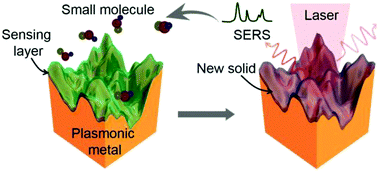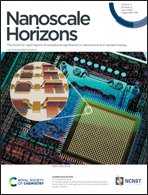Ultrathin layer solid transformation-enabled-surface enhanced Raman spectroscopy for trace harmful small gaseous molecule detection†
Abstract
Detection of trace harmful small gaseous molecules (h-SGMs), based on surface enhanced Raman spectroscopy (SERS), has been expected to be a useful strategy but is challenging due to the extremely small Raman cross section (RCS) and weak metal affinity of the h-SGMs. Here, a new strategy, ultrathin layer solid transformation-enabled (ULSTE)-SERS, is proposed. It uses the chemical reaction between the target h-SGM and an ultrathin layer of solid sensing matter coated on a plasmonic metal SERS substrate. This reaction in situ produces a new solid matter with large RCS, which ensures the detection of trace h-SGMs via SERS. The validity of this strategy has been demonstrated by detecting trace H2S gas with an ultrathin CuO layer wrapped around Au nanoparticles. Furthermore, this strategy allows fast and ultrasensitive detection. The detection limit can be down to ppb (even ppt) levels with 10 min preprocessing. Importantly, this strategy has good universality for various other h-SGMs, such as SO2, CS2, CH3SH, and HCl, etc., using appropriate sensing matter. Additionally, the ULSTE-SERS is also suitable for unstable molecules and fast portable detection due to the stable solid layer. This work provides highly efficient SERS-based detection of trace h-SGMs, which is easily applied in practical situations.



 Please wait while we load your content...
Please wait while we load your content...